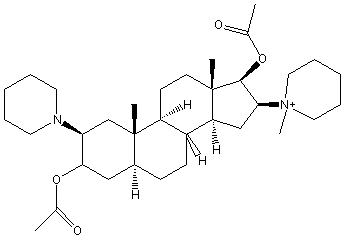Vecuronium
Monoquaternary homolog of PANCURONIUM. A non-depolarizing neuromuscular blocking agent with shorter duration of action than pancuronium. Its lack of significant cardiovascular effects and lack of dependence on good kidney function for elimination as well as its short duration of action and easy reversibility provide advantages over other neuromuscular blocking agents. Vecuronium can be rapidly reversed with sugammadex, so this drug combination offers an alternative to suxamethonium. Sugammadex, unlike neostigmine, does not inhibit acetylcholinesterase so cholinergic effects are not produced and co-administration of an antimuscarinic agent (glycopyrronium bromide or atropine) is not needed
General
Type : Neuromuscular Nondepolarizing Agents,Nicotinic antagonist,Aminosteroid,Piperidine,Drug,Acetate,Not A\/B H target
Chemical_Nomenclature : [(2R,3R,5R,8R,9R,10S,13S,14R,16R,17S)- 17-acetyloxy-10,13-dimethyl-16-(1-methyl-3,4,5,6-tetrahydro-2H-pyridin-1-yl)-2- (1-piperidyl)-2,3,4,5,6,7,8,9,11,12,14,15,16,17-tetradecahydro- 1H-cyclopenta[a]phenanthren-3-yl] acetate
Canonical SMILES : CC(=O)OC1CC2CCC3C(C2(CC1N4CCCCC4)C)CCC5(C3CC(C5OC(=O)C)[N+]6(CCCCC6)C)C
InChI : InChI=1S\/C34H57N2O4\/c1-23(37)39-31-20-25-12-13-26-27(34(25,4)22-29(31)35-16-8-6-9-17-35)14-15-33(3)28(26)21-30(32(33)40-24(2)38)36(5)18-10-7-11-19-36\/h25-32H,6-22H2,1-5H3\/q+1\/t25-,26+,27-,28-,29-,30-,31-,32-,33-,34-\/m0\/s1
InChIKey : BGSZAXLLHYERSY-XQIGCQGXSA-N
Other name(s) : C07553,Piperidinium,Norcuron,NC-45,Monoquat-pancuronium,CHEBI:9939,AC1L22EF,AC1Q5X7S,ORG-NC 45,Musculax,Vecuronium Bromide,Rapacuronium,Org 9487
MW : 557.827
Formula : C34H57N2O4
CAS_number : 50700-72-6 || 86029-43-8
PubChem : 39765
UniChem : BGSZAXLLHYERSY-XQIGCQGXSA-N
IUPHAR : 4002
Wikipedia : Vecuronium_bromide

Target
References (12)
| Title : [Muscle relaxants. New substances and neuromuscular monitoring] - Diefenbach_1997_Anaesthesist_46_3 |
| Author(s) : Diefenbach C , Nigrovic V , Mellinghoff H , Buzello W |
| Ref : Anaesthesist , 46 :3 , 1997 |
| Abstract : Diefenbach_1997_Anaesthesist_46_3 |
| ESTHER : Diefenbach_1997_Anaesthesist_46_3 |
| PubMedSearch : Diefenbach_1997_Anaesthesist_46_3 |
| PubMedID: 9082865 |
| Title : Neostigmine reversal of vecuronium neuromuscular block and the influence of renal failure - Dhonneur_1996_Anesth.Analg_82_134 |
| Author(s) : Dhonneur G , Rebaine C , Slavov V , Ruggier R , De Chaubry V , Duvaldestin P |
| Ref : Anesthesia & Analgesia , 82 :134 , 1996 |
| Abstract : Dhonneur_1996_Anesth.Analg_82_134 |
| ESTHER : Dhonneur_1996_Anesth.Analg_82_134 |
| PubMedSearch : Dhonneur_1996_Anesth.Analg_82_134 |
| PubMedID: 8712389 |
| Title : Influence and relative sensitivities of 50-Hz and 100-Hz tetanic stimuli on subsequent tetanic fade ratios in patients receiving vecuronium - Baurain_1996_Anesth.Analg_82_139 |
| Author(s) : Baurain MJ , Hoton F , Dernovoi BS , d'Hollander AA |
| Ref : Anesthesia & Analgesia , 82 :139 , 1996 |
| Abstract : Baurain_1996_Anesth.Analg_82_139 |
| ESTHER : Baurain_1996_Anesth.Analg_82_139 |
| PubMedSearch : Baurain_1996_Anesth.Analg_82_139 |
| PubMedID: 8712390 |
| Title : [Profile of the effect of succinylcholine after pre-curarization with atracurium, vecuronium or pancuronium] - Ebeling_1996_Anasthesiol.Intensivmed.Notfallmed.Schmerzther_31_304 |
| Author(s) : Ebeling BJ , Keienburg T , Hausmann D , Apffelstaedt C |
| Ref : Anasthesiol Intensivmed Notfallmed Schmerzther , 31 :304 , 1996 |
| Abstract : Ebeling_1996_Anasthesiol.Intensivmed.Notfallmed.Schmerzther_31_304 |
| ESTHER : Ebeling_1996_Anasthesiol.Intensivmed.Notfallmed.Schmerzther_31_304 |
| PubMedSearch : Ebeling_1996_Anasthesiol.Intensivmed.Notfallmed.Schmerzther_31_304 |
| PubMedID: 8767244 |
| Title : Optimum time for neostigmine administration to antagonize vecuronium-induced neuromuscular blockade - Kirkegaard-Nielsen_1995_Eur.J.Anaesthesiol_12_585 |
| Author(s) : Kirkegaard-Nielsen H , Toft P , Severinsen IK , May O |
| Ref : European Journal of Anaesthesiology , 12 :585 , 1995 |
| Abstract : Kirkegaard-Nielsen_1995_Eur.J.Anaesthesiol_12_585 |
| ESTHER : Kirkegaard-Nielsen_1995_Eur.J.Anaesthesiol_12_585 |
| PubMedSearch : Kirkegaard-Nielsen_1995_Eur.J.Anaesthesiol_12_585 |
| PubMedID: 8665881 |
| Title : Spontaneous recovery or evoked reversal of neuromuscular block - Mirakhur_1995_Acta.Anaesthesiol.Scand.Suppl_106_62 |
| Author(s) : Mirakhur RK |
| Ref : Acta Anaesthesiologica Scandinavica Supplementum , 106 :62 , 1995 |
| Abstract : Mirakhur_1995_Acta.Anaesthesiol.Scand.Suppl_106_62 |
| ESTHER : Mirakhur_1995_Acta.Anaesthesiol.Scand.Suppl_106_62 |
| PubMedSearch : Mirakhur_1995_Acta.Anaesthesiol.Scand.Suppl_106_62 |
| PubMedID: 8533549 |
| Title : Genetic variants of human serum cholinesterase influence metabolism of the muscle relaxant succinylcholine. - Lockridge_1990_Pharmacol.Ther_47_35 |
| Author(s) : Lockridge O |
| Ref : Pharmacol Ther , 47 :35 , 1990 |
| Abstract : Lockridge_1990_Pharmacol.Ther_47_35 |
| ESTHER : Lockridge_1990_Pharmacol.Ther_47_35 |
| PubMedSearch : Lockridge_1990_Pharmacol.Ther_47_35 |
| PubMedID: 2195556 |
| Gene_locus related to this paper: human-BCHE |
| Title : [Inhibition of plasma cholinesterase by pancuronium and vecuronium] - Popovic_1990_Lijec.Vjesn_112_142 |
| Author(s) : Popovic L , Kunec-Vajic E |
| Ref : Lijec Vjesn , 112 :142 , 1990 |
| Abstract : Popovic_1990_Lijec.Vjesn_112_142 |
| ESTHER : Popovic_1990_Lijec.Vjesn_112_142 |
| PubMedSearch : Popovic_1990_Lijec.Vjesn_112_142 |
| PubMedID: 1978211 |
| Title : Clinical pharmacology of mivacurium chloride (BW B1090U) infusion: comparison with vecuronium and atracurium - Ali_1988_Br.J.Anaesth_61_541 |
| Author(s) : Ali HH , Savarese JJ , Embree PB , Basta SJ , Stout RG , Bottros LH , Weakly JN |
| Ref : British Journal of Anaesthesia , 61 :541 , 1988 |
| Abstract : Ali_1988_Br.J.Anaesth_61_541 |
| ESTHER : Ali_1988_Br.J.Anaesth_61_541 |
| PubMedSearch : Ali_1988_Br.J.Anaesth_61_541 |
| PubMedID: 2905143 |
| Title : Protein binding of atracurium and other short-acting neuromuscular blocking agents and their interaction with human cholinesterases - Foldes_1983_Br.J.Anaesth_55_31S |
| Author(s) : Foldes FF , Deery A |
| Ref : British Journal of Anaesthesia , 55 :31S , 1983 |
| Abstract : Foldes_1983_Br.J.Anaesth_55_31S |
| ESTHER : Foldes_1983_Br.J.Anaesth_55_31S |
| PubMedSearch : Foldes_1983_Br.J.Anaesth_55_31S |
| PubMedID: 6134540 |
| Title : Differential inhibition of plasma cholinesterase variants using the dibutyrate analogue of pancuronium bromide - Whittaker_1981_Hum.Hered_31_242 |
| Author(s) : Whittaker M , Britten JJ |
| Ref : Hum Hered , 31 :242 , 1981 |
| Abstract : Whittaker_1981_Hum.Hered_31_242 |
| ESTHER : Whittaker_1981_Hum.Hered_31_242 |
| PubMedSearch : Whittaker_1981_Hum.Hered_31_242 |
| PubMedID: 7287015 |